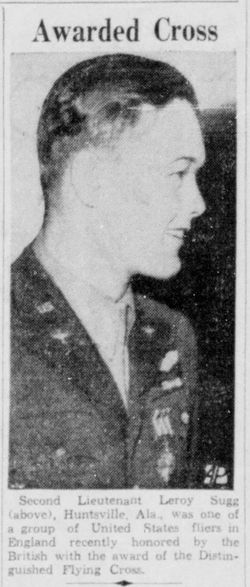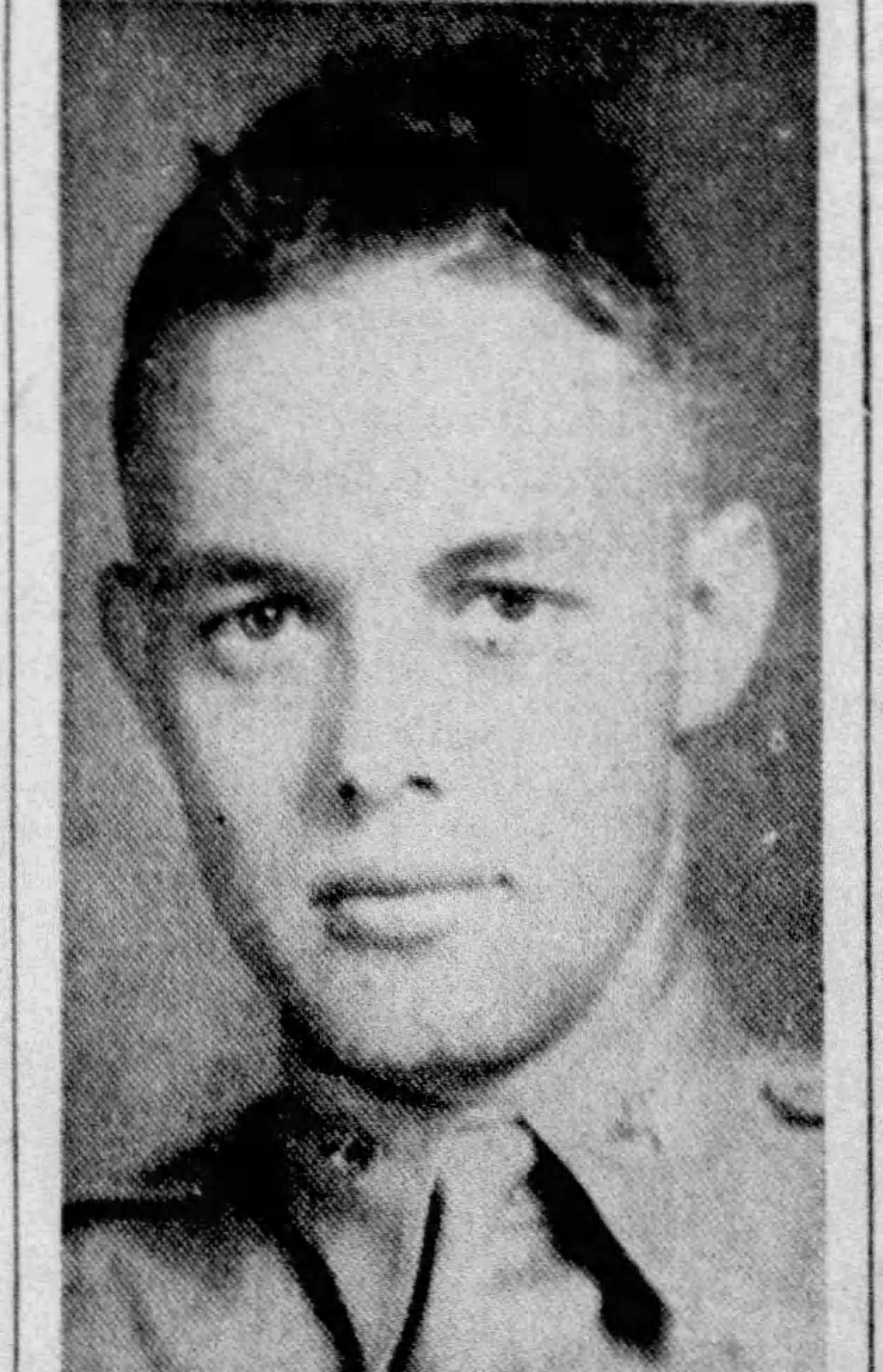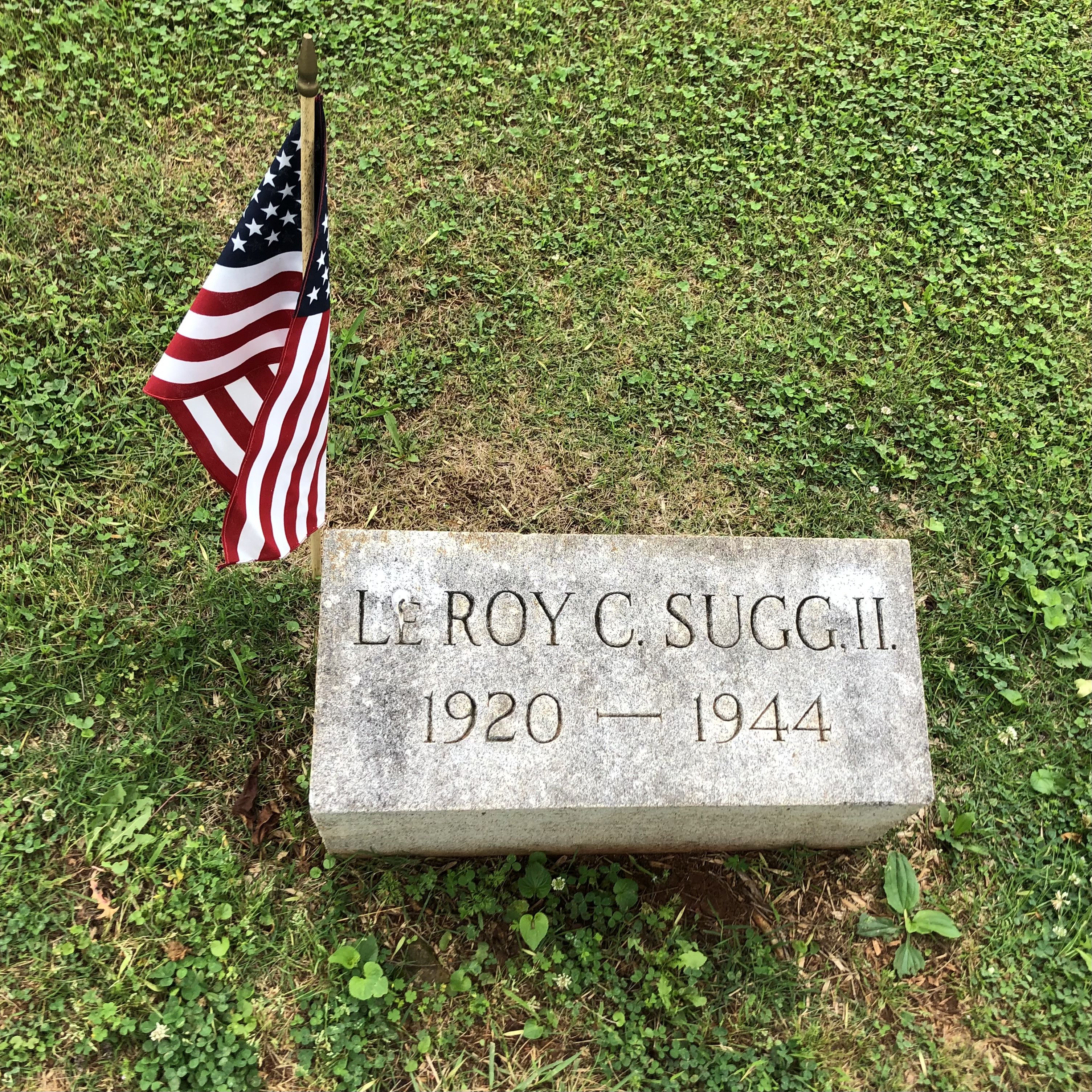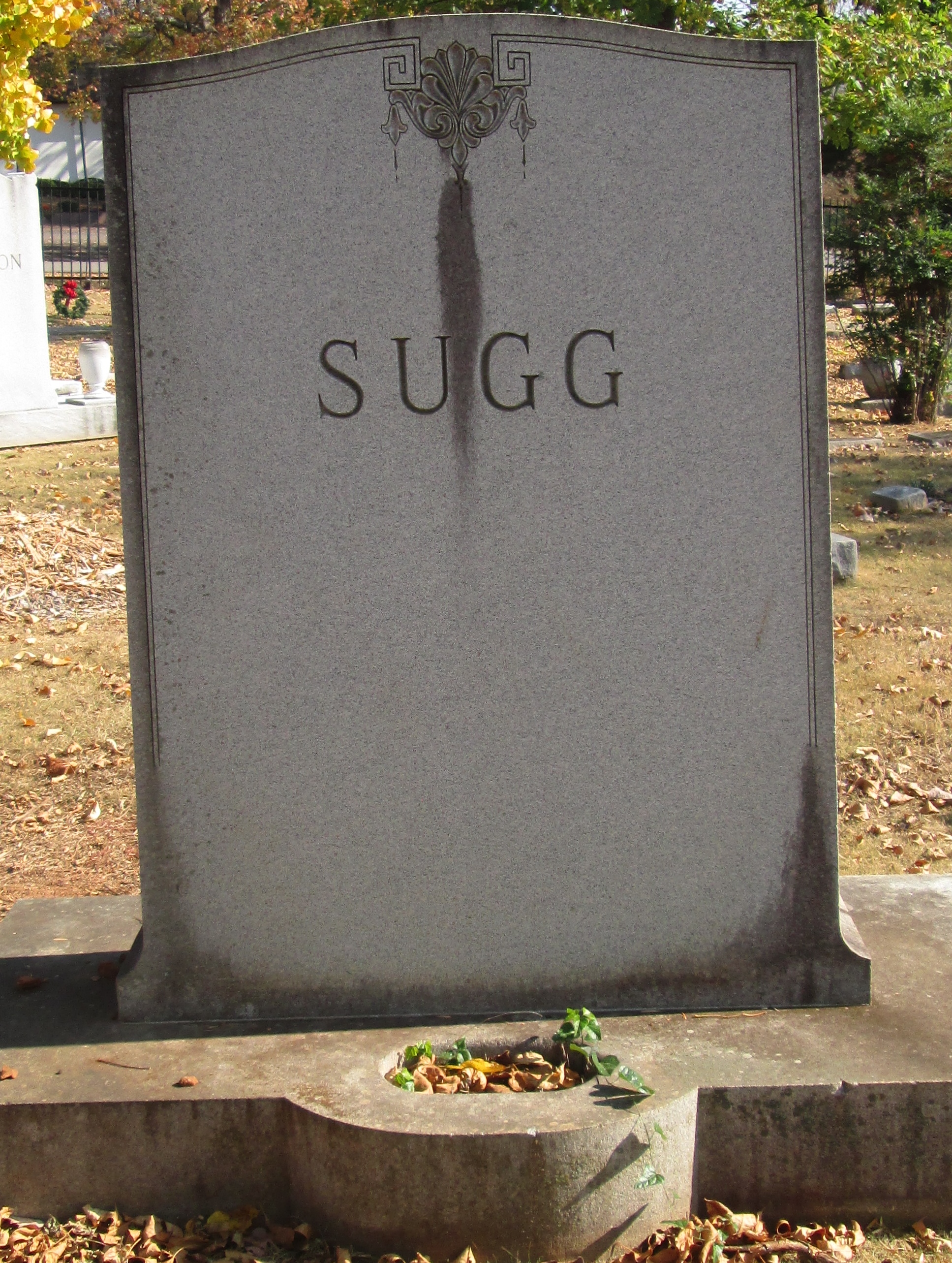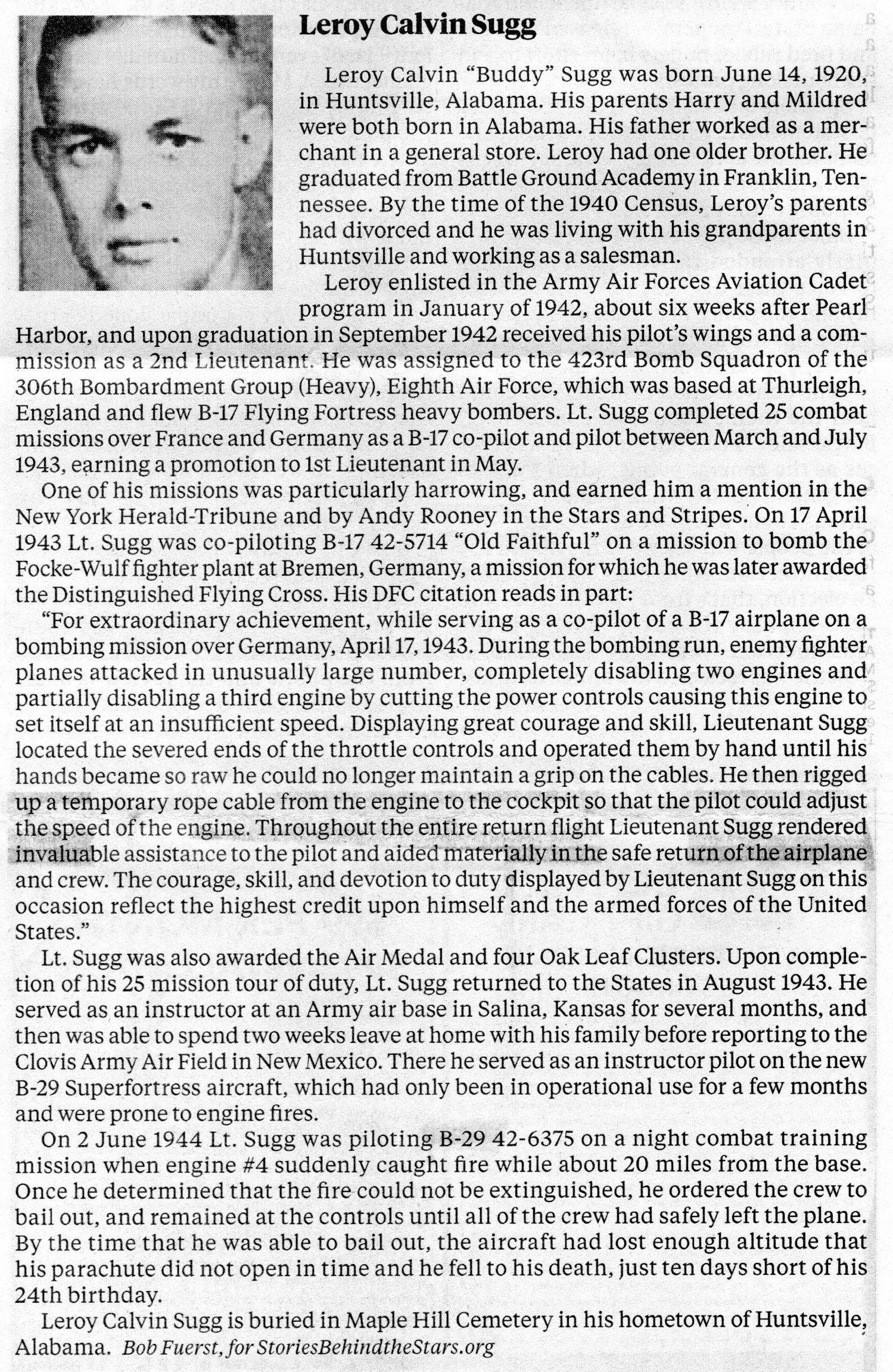LONDON -- When a German shell shot the rudder pedals from under the feet of Lieut. Leroy C. Sugg of Humtsville, Ala., it seemed his job as co-pilot of a Portress was knocked out from under him, too.
But he teamed with Capt. Pcrvis Youree of Walters. Okla., to add another amazing chapter to the long story of planes that come hack.
The same shell which shot up Sugg's control over Bremen recently also cut the cables regulating three of the four engines.
While Youree fought the wildly racing number one engine, Sugg crawled under the catwalk, found the end of the broken cables and brought the motors under control sufficiently for ihe plane to remain in its formation until it was near the continental coast.
With lighter opposition thinning out, it dropped so near the water level that it left a wake on the sea, and all seemed to be going fairly well until the number one engine burned out.
Although tempted several times to crash-land in the sea near some passing ship, Youree kept going until he sighted the British coast and then ordered everything possible jettisoned.
Guns, ammunition, heavy clothes, radios -- all went out and slowly the plane gained altitude, Youree. with the aid of Sugg, managed to keep it going until he sighted a field and then brought the bomber down safely, although one of the landing wheels could be only partially lowered.
Besides themselves. Youree and Sugg saved these fellow crewmen: Lieut. George S. Homer of Toledo. Ohio, bombardier who got his bombs away before the shell hit and later helped shoot down a Focke-Wll 190. Lieut. James S. Chaney of Palatka, Fla.. the navigator, Sgt. Henry H. Bean of Dos Cobezos, Ariz., radio operator, Sgt. William R. Wilkemeon, Jr., of Townsend, Ga,. top turret gunner whose guns were shot out of action by another shell, Sgt. Kenneth N. McCIure of Youngstown, Ohio, ball turret gunner, Sgt. Louis A. Skinner of Elk City. Kans., right waist gunner, Sgt. Fred I. Colvard of Worland. Wyo., left waist gunner, Sgt. William V. Baker of New York City, tail gunner.
The gunfire Interrupter, a tiny device used on bombers and combat planes, prevents gunners from inadvertently shooting the tail or other parts off of their own planes.
Originally published in The Anniston Star on Thursday, April 22, 1943 Page 8
~~~~~~~~~~~~~~~~~~~~~~~~~~~~~~
ALABAMA AIR HERO
When a German shell shot the rudder pedals from under the feet of Lieut. Leroy C. Sugg (above) ol Huntsville. Ala., he teamed with his pilot, Capt. Pervls Youree of Walters, Okla., to add another amazing chapter to the long story of disabled American planes that came back from enemy territory in Europe.
The shell also cut the cables that regulated three of the four motors. Lieut. Sugg, co-pilot of the plane, crawled under the catwalk, found the broken cables and brought the engines under control sufficiently to remain in the air and get back to England.
Sugg is the step-son of Reese T. Amis, editor of The Huntsville Times.
Originally published in The Anniston Star on Tuesday, April 27, 1943 -- Page 1
~~~~~~~~~~~~~~~~~~~~~~~~~~~~~~
Information submitted by Tim Cook:
First Lieutenant Sugg served with the 234th Base Unit from Clovis Army Airfield, New Mexico.
He was the pilot of B-29 Super fortress #42-6375. He was killed attempting to bail out of the four motored bomber when an on board fire forced an abandonment, eighteen
miles southeast of the airfield.
Corporal Gilbert F. Davidson also perished.
LONDON -- When a German shell shot the rudder pedals from under the feet of Lieut. Leroy C. Sugg of Humtsville, Ala., it seemed his job as co-pilot of a Portress was knocked out from under him, too.
But he teamed with Capt. Pcrvis Youree of Walters. Okla., to add another amazing chapter to the long story of planes that come hack.
The same shell which shot up Sugg's control over Bremen recently also cut the cables regulating three of the four engines.
While Youree fought the wildly racing number one engine, Sugg crawled under the catwalk, found the end of the broken cables and brought the motors under control sufficiently for ihe plane to remain in its formation until it was near the continental coast.
With lighter opposition thinning out, it dropped so near the water level that it left a wake on the sea, and all seemed to be going fairly well until the number one engine burned out.
Although tempted several times to crash-land in the sea near some passing ship, Youree kept going until he sighted the British coast and then ordered everything possible jettisoned.
Guns, ammunition, heavy clothes, radios -- all went out and slowly the plane gained altitude, Youree. with the aid of Sugg, managed to keep it going until he sighted a field and then brought the bomber down safely, although one of the landing wheels could be only partially lowered.
Besides themselves. Youree and Sugg saved these fellow crewmen: Lieut. George S. Homer of Toledo. Ohio, bombardier who got his bombs away before the shell hit and later helped shoot down a Focke-Wll 190. Lieut. James S. Chaney of Palatka, Fla.. the navigator, Sgt. Henry H. Bean of Dos Cobezos, Ariz., radio operator, Sgt. William R. Wilkemeon, Jr., of Townsend, Ga,. top turret gunner whose guns were shot out of action by another shell, Sgt. Kenneth N. McCIure of Youngstown, Ohio, ball turret gunner, Sgt. Louis A. Skinner of Elk City. Kans., right waist gunner, Sgt. Fred I. Colvard of Worland. Wyo., left waist gunner, Sgt. William V. Baker of New York City, tail gunner.
The gunfire Interrupter, a tiny device used on bombers and combat planes, prevents gunners from inadvertently shooting the tail or other parts off of their own planes.
Originally published in The Anniston Star on Thursday, April 22, 1943 Page 8
~~~~~~~~~~~~~~~~~~~~~~~~~~~~~~
ALABAMA AIR HERO
When a German shell shot the rudder pedals from under the feet of Lieut. Leroy C. Sugg (above) ol Huntsville. Ala., he teamed with his pilot, Capt. Pervls Youree of Walters, Okla., to add another amazing chapter to the long story of disabled American planes that came back from enemy territory in Europe.
The shell also cut the cables that regulated three of the four motors. Lieut. Sugg, co-pilot of the plane, crawled under the catwalk, found the broken cables and brought the engines under control sufficiently to remain in the air and get back to England.
Sugg is the step-son of Reese T. Amis, editor of The Huntsville Times.
Originally published in The Anniston Star on Tuesday, April 27, 1943 -- Page 1
~~~~~~~~~~~~~~~~~~~~~~~~~~~~~~
Information submitted by Tim Cook:
First Lieutenant Sugg served with the 234th Base Unit from Clovis Army Airfield, New Mexico.
He was the pilot of B-29 Super fortress #42-6375. He was killed attempting to bail out of the four motored bomber when an on board fire forced an abandonment, eighteen
miles southeast of the airfield.
Corporal Gilbert F. Davidson also perished.
Family Members
Other Records
Sponsored by Ancestry
Advertisement
Advertisement
